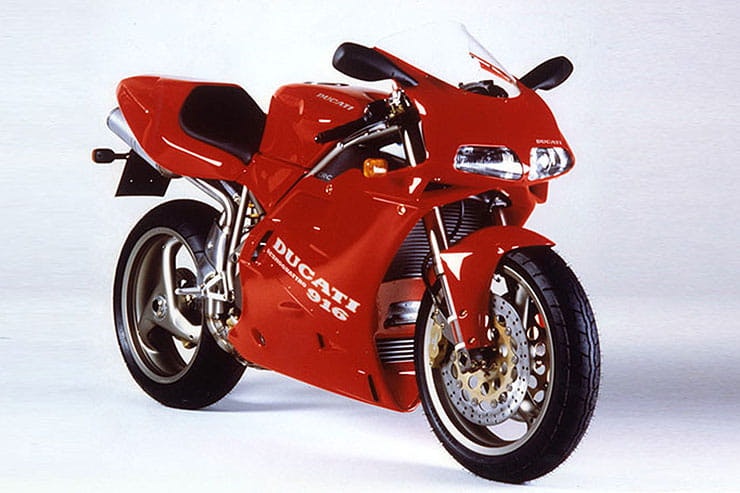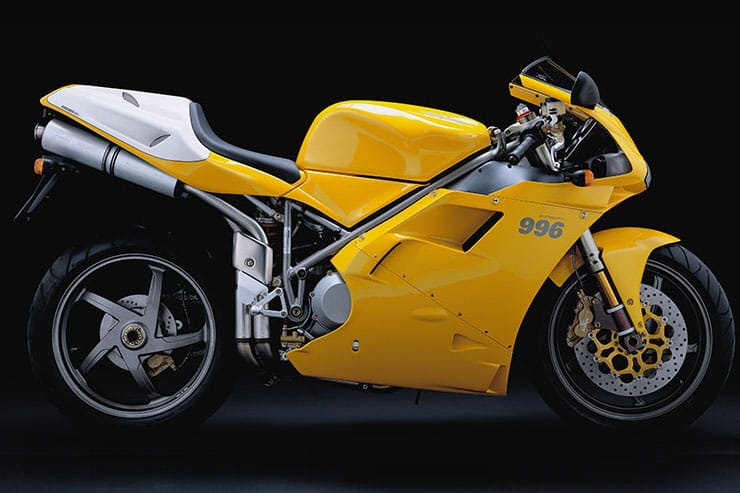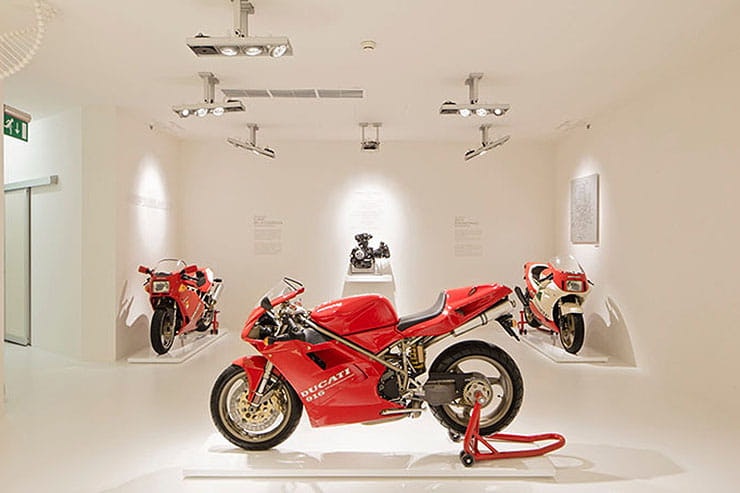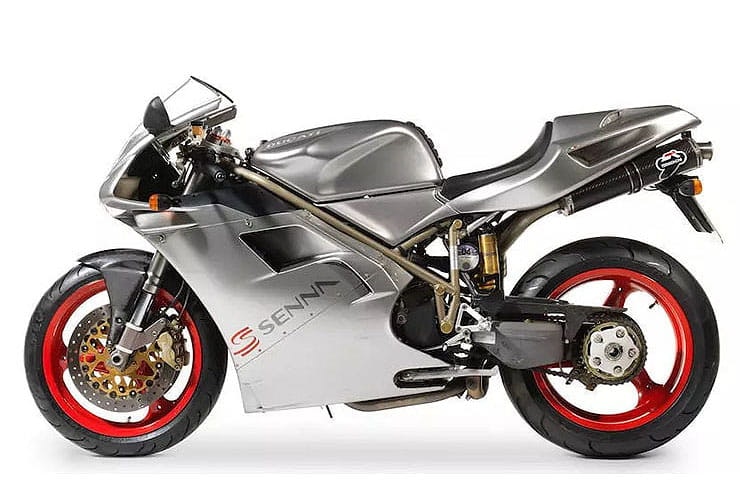Ducati 916/996/998 (1994-2003): Review & Buying Guide
By Jim Moore
Bike journo for a quarter of a century
15.08.2023
Price: £9000-£10,000 (mint Biposto) | Power: 114-123bhp | Weight: 204-198kg | Overall BikeSocial Rating: 5/5
Ducati was reborn in the ’90s, a resurgence brought about by two models. Firstly, the simple and unique (at the time) M900 Monster became an unexpected sales success, saving the firm’s financial bacon at a time when its future could have gone either way. The other machine that underpinned Ducati’s future success was the 916 superbike. Achingly gorgeous to look at and a weapon on track, the 916 and its 996/998 derivatives stole hearts in the showroom and won no less than six WSB titles over a glorious eight-year run.
Numerous replacements have come and gone since the 998 bowed out at the end of 2002 – Ducati even tried reinventing the 916’s styling with the 1098, after the less than pretty 999 was retired at the end of 2006 – but no model since has matched the 916’s blend of beauty, performance and appeal. As such, this family of V-twins are arguably the most desirable Italian modern classics. What’s more, they’re still affordable, too, in Biposto form at least…
A 916 is as exciting to ride as it is gratifying to look at, and once you step on board there’s little doubt about the bike’s intent. The racing DNA is unmistakable. Previous 851/888 superbikes were spacious armchairs by comparison: with a 916 it’s head down, arse up, and ten-tenths riding is very much the order of the day.
Ridden as intended a 916/996/998 will sweep aside corners and curves with delicious ease, while emitting a glorious V-twin soundtrack laced with racing pedigree. Other V-twin superbikes are faster, more powerful, more sophisticated, but none tread the line between character, modernity and sheer pin-point brilliance as ruthlessly or effectively as these Bologna classics.
Ducati 916/996/998 (1994-2003) Price
The 916 family covers a wide range of models, specs, capacities, and values. The original 916, the Strada, is sought after by collectors, a) because it’s a first of type, and b) it comes with unique Cagiva era spec. Entry level to 916/996/998 ownership is the twin seat Biposto models (some owners fit a single seat and remove the pillion pegs, so don’t be fooled into paying more for a fake Strada, SP etc).
916 values: Rough £4500-£5500; Tidy £6500-£7500; Mint £8000-£9000 (for Strada add £2000-£3000; SP/SPS models can command anything up to £30K)
First model 916s (1994) are called 916 Strada, notable by their single seat unit and Cagiva logos on various castings (Ducati was still owed by Cagiva at the time); 114bhp Strada was complimented by the race homologation spec SP model with white number boards, Öhlins shock, twin injectors, 126bhp motor and carbon fibre mudguard, plus other upgrades.
Twin seat Biposto model made from 1995 (considered the base model for any buyer), plus 300 limited edition graphite coloured ‘Senna’ reps – Senna II and Senna III models launched later. Saucy race-ready models were updated; a 955cc model for AMA Racing in the States and a 996cc SPS (still called 916) for WSB, making 134bhp. A final UK-only replica appeared in 1998, the Foggy rep 916SPS, which allowed Ducati to homologate a larger airbox for racing. Only 202 were built. Colours: Strada, red. Biposto, red, yellow. SP/SPS, red. Senna, graphite/orange.
996 values: Rough £4500-£5500; Tidy £7000-£8000; Mint £9000-£10,000 (R models can command anything up to £25K; S £15K)
For 1999 the Biposto was given a capacity upgrade to 996cc, as well as updated front discs, a new alternator and a cleaner logos, plus new five-spoke Marchesini wheels and revised side stand from 2000. The 996SPS got its own engine change in 2000, with the 998cc Testastretta (narrow head) unit, and Öhlins forks, as well as a name change to the 996R. Power increased to a claimed 135bhp. A further model, the 996S, blended Biposto spec with a few parts from the older SPS, like gearbox, cams and suspension; power claimed at 123bhp. Colours: Biposto, red, yellow. R, red. S, red, yellow.
998 values: Rough £5000-£5800; Tidy £7000-£8000; Mint £9000-£10,000 (For R and S see 996)
The final throw of the dice for the 916 family saw the Biposto gain the 998cc Testastretta engine and take advantage of its 123bhp potential. R and S models as per 996, plus two special edition models – the dark green coloured ‘Matrix’, as used in the film – and the 998 Final Edition. Colours: Biposto, red, yellow. Matrix, green. Final Edition, red.
Arguably the most beautiful motorcycle ever built.
Fabulous balance of handling and performance.
Appreciating classics.
Uncomfortable to ride at anything less than 8/10ths.
Not a push-button thrill - needs fastidious maintenance.
Bikes from collections can need expensive recommissioning.
Ducati 916/996/998 (1994-2003) Engine and Performance
The 916 engine is an evolution of the liquid-cooled, DOHC, four-valve, 90° L-twin that first found a home in the 851 and 888 superbikes. Increasing the stroke by 2mm took capacity to 916cc. Early models (Strada) feature Pankl con rods, while the Weber-Marelli engine management system is similar to units used in Ford Sierra Cosworths and Ferrari F40s…
The 996 displacement was achieved by adding 4mm extra on the bore, but the 998 engine, while featuring a further 2mm increase in bore size, uses a reduced 63.5mm stroke as well as a steeper valve angle (from 40° to 25°) to increase revs and therefore power. All models feature dry clutches – the cycle bell rattle at idle is normal.
The big advantage enjoyed by any of these thumping Ducati V-twins is immense, accessible low and midrange torque – just what you need to fire off corners onto the next straight. And despite their large capacity and substantially sized pistons, all models like to rev. Peak power doesn’t appear until 10,000rpm and the swell of torque keeps coming until 7000-8000rpm, depending on model and spec.
Mechanical reliability is excellent across all models, but it all hinges on regular maintenance. Cam belts need replacing every two years, regardless of mileage – ignore them at your peril. A snapped belt can cause carnage. Servicing receipts are an essential part of any 916/996/998 deal.
Ducati 916/996/998 (1994-2003) Handling & Suspension
Light and compact. They were the two touch stones of the 916 de
sign team when creating the bike’s chassis, styling and dimensions. Plans for the 916 began at the Cagiva Research Centre as early as 1986-’87, with Massimo Tamburini steering the bike’s design and engineering concepts.
The tubular steel frame followed Ducati’s favoured lattice design, but was stiffer, lighter and more compact than any previous model. Overall styling – particularly the headlamps, underseat pipes, and single-sided swingarm - was inspired by Honda’s NR750, Tamburini later revealed.
Handling is beautifully balanced and precise, even by modern standard, although comfort doesn’t get a look in. Steering is accurate yet composed thanks to the top-mounted steering damper. Early models featured Japanese Showa forks and shock; SP and SPS models gained an Öhlins damped rear end. Later R models complimented their Swedish shock with Öhlins forks. Original three-spoke Brembo wheels were eventually updated across all models to five-spoke Marchesinis.
Ducati 916/996/998 (1994-2003) What to look for
Cam belts: Change them every two years without fail, and regardless of mileage, and you won’t go far wrong. A competent home mechanic could tackle this job, otherwise you’re looking several hundred quid labour, plus parts, for a garage to do thew work. Don’t skimp on belts – they’re not that expensive (around £100 each) , whereas the aftermath of belt failure can be wallet-crushing…
Starter clutch: Every time you push the starter button, you’re asking the sprag clutch to spin a hefty crankshaft and two large pistons into action. Attempting to do this on a less than healthy battery can ruin said starter clutch. Luckily repair is not an engine-out job, and a new starter clutch can be had for around £150.
Air filter: If you like wheelies – especially long ones – your Ducati’s air filter won’t be impressed. Under such use engine can spit back via the breather and into the airbox; a messy end to high jinks. BMC Filters make an aftermarket filter (natch) that’s said to be superior to the original.
Clutch: Dry clutches can be noisy. Knackered dry clutches even more so, and they do wear with age. The hydraulic slave cylinders give out all too often – tell-tale signs are leaking fluid and overly light lever action. Many owners recommend fitting a more durable aftermarket slave cylinder to cure or at least minimise the need for maintenance.
Patina: 916 and 998 models range between 20-30 years old by now, so signs of usage, wear and tear and even corrosion will have left their mark on most examples. Engine paint was never that good and tends to flake off over time, fastners corrode, bodywork panels can crack around the Dzus fastner points, temp gauges can trap condensation, and the auto retracting stands have caused many a 9 family Ducati to land ungracefully on its side, so check left hand panels, controls and mirrors.
Which model: There are a bamboozling number of different models in the 916/996/998 family, from the first single-seat 916S and twin-seat Biposto to SP, SPS, S, R models and numerous special editions, from Senna to Foggy. It’s not beyond the wit of an unscrupulous seller to sex-up a Biposto into something more desirable or pass off normal 996/998 as a more sought-after special edition. So, check VIN and reg numbers carefully – if in doubt, as a Ducati dealer or Ducati UK themselves to verify the authenticity of a particular machine before handing over any cash. Could save you thousands…
Ducati 996 (1998) Rivals
Aprilia RSV 1000 Mille, 1998 | Approx Value: £2000-£5500
Power/Torque: 128bhp/76lb-ft | Weight: 189kg (dry)
A brilliant first attempt by Aprilia to beat Ducati at their own game. Strong engine, generous ergonomics (a Mille’s a much better fit for a larger rider than a 916) and decent handling are the package’s strong points, but the early bikes’ stock shock is poor. Second gen Milles (from 2001) are better still.
Triumph 955i Daytona, 1998 | Approx Value: £2500-£5000
Power/Torque: 130bhp/74lb-ft | Weight: 198kg (dry)
Characterful triple that makes a great road bike if you can live with the low bars. Not as sharp on track on for 10-10ths riding as the Ducati, but starting to feature on ‘must have’ lists, if only for the meaty motor and unique looks. First year yellow bikes are most sought after.
Suzuki TL1000R, 1998 | Approx Value: £2500-£5000
Power/Torque: 135bhp/78lb-ft | Weight: 197kg (dry)
Failed as a racer and flopped as a road bike, the TL-R lacked the punch and excitement of the TL1000S, despite offering more power, but has now become something of a cult bike. Nowhere near as a sharp, beautiful or comfortable as a Ducati, but more affordable as a result. Can be made much better with a few choice mods, starting with a new rear shock.
Ducati 916/996/998 (1994-2003) Verdict
The 916 and derivatives remain a stand-out in Ducati’s modern model history. A multiple winner on track and unsurpassed in terms of pure elegance and beauty, these legendary L-twins remain a object of lust and desire for many of us. Indeed the 916’s appeal extends way beyond the two-wheeled world – Tamburini’s styling won design awards at the time and continues to inspire some 30 years on. And while many of the SP and special edition models have now increased in value way beyond most average pockets, the twin-seat Biposto is still an affordable modern classic that’ll give as much pleasure every time you clap eyes on it as it will in terms of riding.
Ducati 996 (1998) – Technical Specification
If you’d like to chat about this article or anything else biking related, join us and thousands of other riders at the Bennetts BikeSocial Facebook page.
Looking for motorcycle insurance? Get a quote for this motorbike with Bennetts bike insurance



